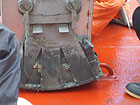

 | |||||||||||||||||
|
|
Journals 2007/2008Caitlin Munroe
August 6, 2007 Location: Hudson Bay, Belcher Islands, Sanikiluaq We arrived in the Belchers around 5 this morning, the channel into this bay can only be navigated at high tide. The Amundsen is here for 2 days of the Inuit Health survey as well as community visits to see the ship. Villagers will be coming aboard for health checks while several of us will be giving tours to groups of villagers and some others are giving brief talks and/or demonstrations of the type of science they are doing on board. There are a few lucky individuals who have neither responsibility and will be able to catch up on work, sleep, or relaxation. I filtered last night's water sample after breakfast, the first tour Fiona and I give will be this afternoon for a group of elders from the village, until then many of us are just waiting around. We are fairly close to land and there are several small hills whose rocky slopes seem to be calling out, telling us to come explore, go for a hike, but no one is going ashore unless they have official Amundsen business. As I am not a part of the mooring team (who will spend much of the day onshore, calibrating the mooring instruments) I will be staying on board. The tour group was made up of around 10 elders from Sanikiluaq and we started out by heading down to the Crew's Lounge so they could leave their jackets and backpacks in a dry place. Fiona got a bit shy and left the talking to me, lucky I'm a teacher and used to presenting to groups! We began on the foredeck where Josee showed us the Tucker Oblique Trawl, the Hydrobios Net, and some samples of zooplankton. Next, Bruce talked about the tower and the atmospheric equipment he uses. Klaus showed the Hypersas instrument mounted on the bow and spoke about the way it measures ocean color. There were 7 other stations which included: box coring, nutrients, contaminants, the rosette, the helicopter (no rides, just a tour), bottom mapping with the Multi Beam, and the Bridge or Wheelhouse. The Bridge was the most popular, hands down! Everyone on the tour seemed interested, many asked questions, and a few people snapped pictures almost non-stop. I had a great time getting to know their names, learning about their families and their village, and answering some questions about Colorado. The tour took almost 90 minutes, so they were ready for a snack in the Crew's Mess before a meeting with Dave Barber, Chief Scientist, and the Health survey folks.
|
||||||||||||||||


